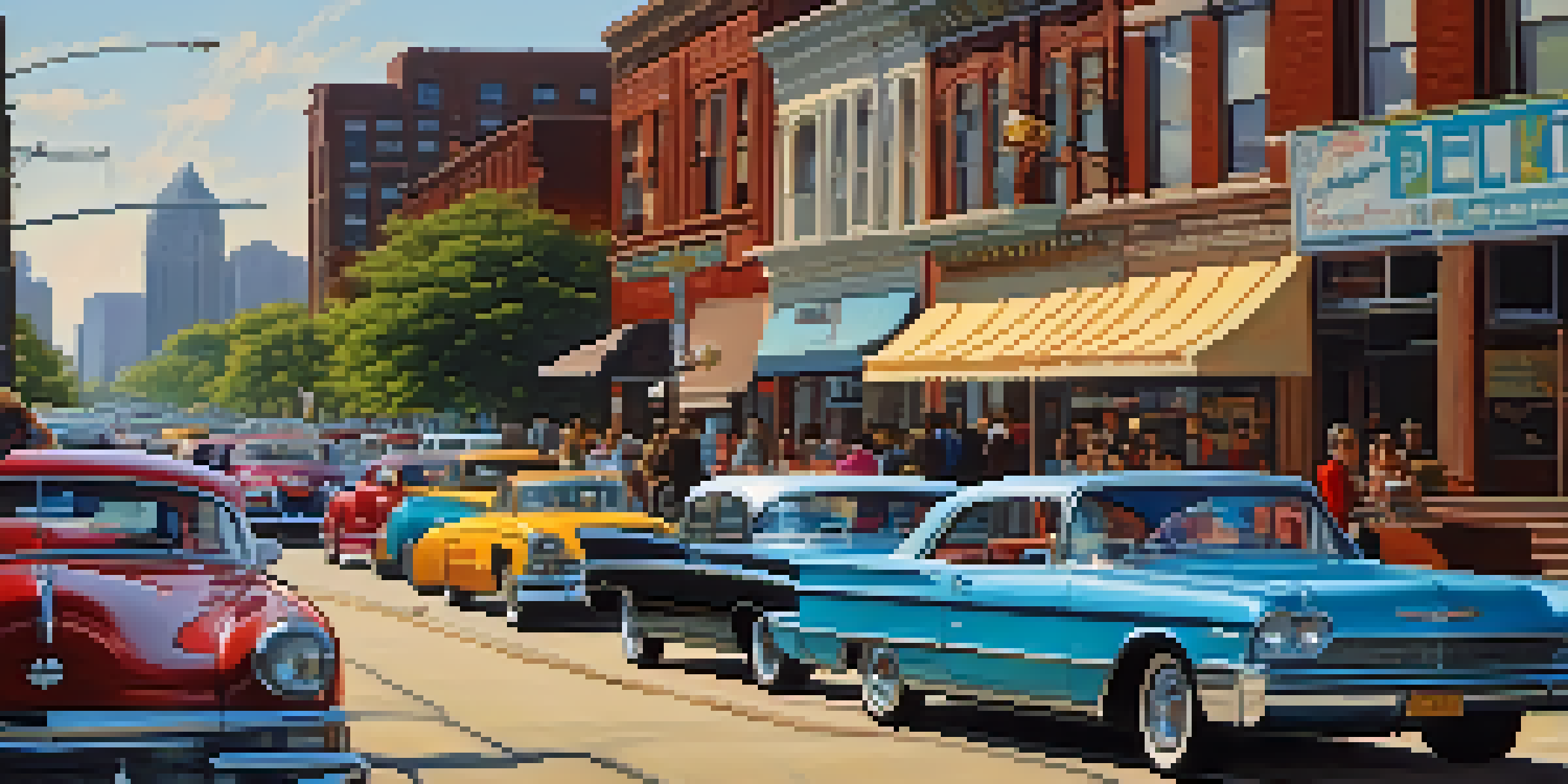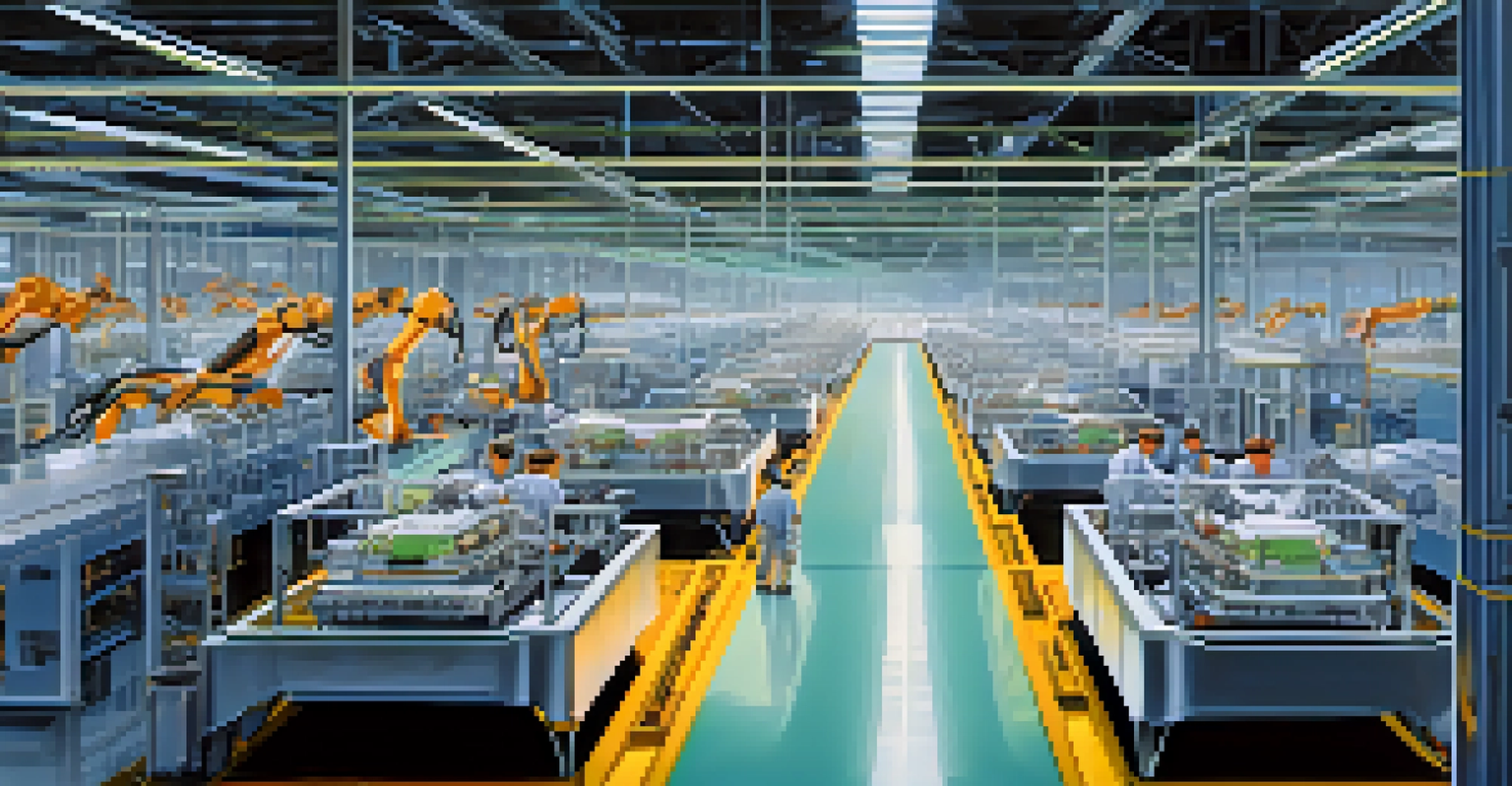The Impact of the Big Three on Detroit’s Automotive Legacy

Introduction to the Big Three Automakers
The Big Three refers to the trio of American automotive giants: General Motors, Ford, and Stellantis (formerly Chrysler). These companies have not only defined the automotive landscape but have also played a pivotal role in shaping Detroit's identity as the Motor City. Understanding their impact is essential to appreciating the rich automotive heritage of this vibrant city.
The automobile has become a symbol of freedom and personal mobility, a testament to human innovation and ingenuity.
Each of these automakers has contributed to Detroit's economy and culture in unique ways, from introducing assembly line production to creating iconic vehicles. Their innovations have set trends that reverberate throughout the global automotive industry. The story of Detroit cannot be told without acknowledging the monumental influence of these companies.
As we delve deeper into the impact of the Big Three, we'll explore how their histories intertwined with the city's growth, the challenges they faced, and their ongoing legacy in shaping not just vehicles but the very fabric of Detroit itself.
Economic Impact of the Big Three
The economic influence of the Big Three on Detroit is profound and multifaceted. At their peak, these automakers employed thousands of workers, fueling the local economy and providing livelihoods for countless families. The ripple effect of this employment extended to suppliers, dealerships, and service industries, creating a robust network of economic activity.

However, this economic dominance also came with challenges. The reliance on the automotive industry made Detroit vulnerable to market fluctuations, as seen during economic downturns. When the Big Three struggled, so did the city, leading to job losses and economic decline, which highlighted the precarious nature of such concentrated industry reliance.
Economic Impact of the Big Three
The Big Three automakers have significantly shaped Detroit's economy by providing thousands of jobs and creating a robust network of suppliers and service industries.
Despite these challenges, the Big Three have shown resilience, adapting to market demands and technological advancements. Their ability to pivot has not only helped them survive but also stimulated new economic opportunities, showcasing the dynamic nature of Detroit's automotive legacy.
Cultural Significance of the Big Three
Beyond economics, the Big Three have deeply influenced Detroit's culture, becoming integral to the city’s identity. The automotive industry has inspired artistic expressions, from music to film, with Motown and classic car shows celebrating this heritage. Automobiles are not just modes of transport; they symbolize freedom and innovation, resonating with Detroit's spirit.
Innovation distinguishes between a leader and a follower.
Car culture in Detroit is palpable, with events like the Detroit Auto Show drawing enthusiasts and showcasing the latest advancements. This annual event represents a convergence of tradition and future, allowing the Big Three to display their innovations while celebrating their storied past. These cultural touchpoints foster a sense of pride among residents.
Moreover, the branding and marketing campaigns by these companies have left a lasting impression on American culture. Iconic slogans and memorable advertisements have become part of the collective memory, further solidifying the Big Three’s place in not just Detroit, but American history.
Technological Innovations from the Big Three
The Big Three have been at the forefront of automotive innovation, introducing groundbreaking technologies that have transformed the industry. From the assembly line production methods pioneered by Ford to the electric vehicle advancements by GM, these companies have consistently pushed the envelope. Their commitment to research and development has made them leaders in automotive technology.
In recent years, the focus has shifted towards sustainability, with the Big Three investing heavily in electric and hybrid vehicles. This shift not only addresses environmental concerns but also positions them competitively in a rapidly changing market. By prioritizing innovation, they continue to reshape the future of transportation.
Cultural Significance of Automakers
The Big Three have influenced Detroit's culture, inspiring artistic expressions and fostering a sense of pride among residents through events like the Detroit Auto Show.
Moreover, their collaborations with tech companies in areas like autonomous driving highlight their adaptability. By embracing new technologies, the Big Three are not only preserving their legacy but also ensuring that Detroit remains a pivotal player in the global automotive arena.
Challenges Faced by the Big Three
Despite their successes, the Big Three have faced numerous challenges throughout their history. Economic recessions, shifts in consumer preferences, and intense global competition have all tested their resilience. The 2008 financial crisis was a particularly stark reminder of how vulnerable even the largest companies can be.
During this crisis, the Big Three had to seek government bailouts to stay afloat, a situation that raised questions about the sustainability of their business models. This period of struggle forced them to reevaluate their strategies, leading to significant restructuring and a renewed focus on efficiency and innovation.
Additionally, the rise of foreign automakers and changing consumer preferences towards more sustainable options have pushed the Big Three to adapt rapidly. These challenges, while daunting, have also served as catalysts for change, prompting the companies to evolve and redefine their roles in the automotive industry.
The Big Three's Influence on Workforce Dynamics
The Big Three have significantly influenced workforce dynamics in Detroit, shaping labor relations and employment practices. For decades, these automakers provided stable, well-paying jobs, attracting workers from various backgrounds and contributing to the city’s diverse demographic. This influx of talent has enriched Detroit's cultural tapestry.
However, the relationship between the Big Three and their workforce has not always been smooth. Strikes and labor disputes have punctuated their history, highlighting the ongoing struggle for workers' rights and fair wages. These conflicts have prompted changes in labor laws and practices, reflecting the evolving nature of work in America.
Future Innovations and Challenges
As the Big Three pivot towards electric vehicles and smart technologies, they face both challenges and opportunities that will shape the future of Detroit's automotive landscape.
Today, as the industry pivots towards technology and automation, new challenges and opportunities arise for the workforce. The Big Three are now tasked with retraining employees and creating pathways for careers in emerging fields, ensuring that Detroit's workforce remains competitive in the global market.
Future Outlook for the Big Three and Detroit
As we look to the future, the Big Three are at a crossroads, facing both challenges and opportunities in a rapidly changing automotive landscape. The push towards electric vehicles and sustainable practices is reshaping their strategies, with a commitment to reducing carbon footprints and embracing new technologies. This transformation is vital not only for the companies but for the city of Detroit as well.
Furthermore, the global shift towards digitalization and connectivity presents new avenues for innovation. The Big Three are exploring options like smart cars and integrated mobility solutions, positioning themselves as leaders in the next generation of automotive technology. This evolution could pave the way for a revitalized Detroit economy, centered around innovation and sustainability.

Ultimately, the ongoing relationship between the Big Three and Detroit will play a crucial role in the city’s future. By embracing change while honoring their legacy, these automakers can continue to inspire new generations and maintain Detroit's status as a hub of automotive excellence.